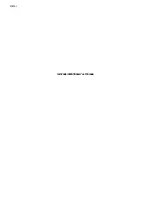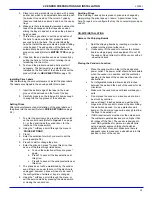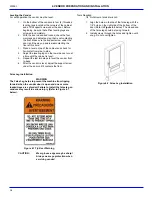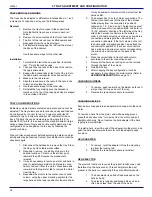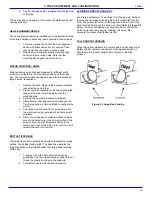
L0126J
26
the coin mech was the critical peripheral. In a cashless-only
system, the card reader was the critical peripheral. Bill-only
applications were not supported, so an unhealthy validator was
never sufficient to take the machine out-of-service.
In this firmware, the machine will only go out-of-service if at first
at least one peripheral becomes unhealthy, then all peripherals
become unhealthy.
REMAINING IN SERVICE W/O COIN MECH
If a bill validator is present, and the coin mech becomes
unhealthy, the VMC will continue running with the bill validator
(and cashless if present). Over the past several years, the criteria
for an “unhealthy” finding have become more stringent, as
various reported error conditions such as coin jams were
removed from out-of-service consideration. Right now, in
practical terms, the coin mech either has to burn out completely
or become disconnected to be considered unhealthy by the
VMC’s criteria. A healthy coin mech going unhealthy should be a
rather rare occurrence.
To help notify patrons and service personnel that the coin mech
has become unhealthy, the EXACT CHANGE message will be
activated. This should discourage patrons from inserting paper
money, unless the prices happen to be in paper money
increments. Also, patrons trying to feed coins into the mech will
notice immediately that the coins disappear (in the case of a
serious coin jam) or fall through.
“#” KEY FOR ESCROW RETURN
In bill-only applications, there is no classic coin return button to
request return of the last-inserted bill. As a result, when the coin
mech is considered unhealthy, the “#” key will be treated as
equivalent to a coin mech escrow return.
BILL-ONLY APPLICATION NOTES:
In a bill-only system, prices must be restricted to the scaling
factor of the bill validator. Usually, this scaling factor will start
from the smallest paper currency unit instead of the smallest coin
unit. This will limit setting selection prices that would require
change-making.
Due to the absence of a coin mech, the normal
No Cheat
logic is
disabled, regardless of the VMC option setting. The VMC’s
fairness is limited to not taking in more money than the maximum
price in the machine. As mentioned earlier, the ‘#’ key is
equivalent to escrow return, possibly allowing the patron to
retrieve the last-inserted bill.
The EXACT CHANGE message should never occur in a pure bill
-only system.
BILL PLUS CASHLESS APPLICATION NOTES
Prices will be restricted to the scaling factor of the cashless
device, which is usually the smallest coin unit.
Revaluation occurs in the same way it does with a coin mech,
except in cases where the payment medium is at or near its
maximum balance. With a coin mech, the VMC will allow credit to
exceed the maximum balance as long as any excess can be paid
back in coins. Without a coin mech, the VMC rejects any bills that
would exceed the maximum balance (in a card-first revaluation)
or rejects the payment medium entirely (in a cash-first
revaluation).
Hide Card Value
Use this feature to display or not display the value on the card.
When enabled, this will prevent the credit amount from being
displayed during a card swipe. This can avoid confusion for the
customer when the maximum priced value is displayed before
making a selection for a lesser cost product.
Press “8” to change the YES to a NO and again to change it
back. Press”#” to save any change and exit this feature.
Card Refund
should be enabled only for certain card readers
that have difficulty processing refunds. Any credit displayed after
a failed vend will be held for 15 minutes. Additional credit may be
added to this
un-refundable
credit for other purchases.
Press “9” to change the YES to a NO and again to change it
back. Press”#” to save any change and exit this feature.
OPTIONS
Message
The user can customize the scrolling message that is displayed
when the vendor is idle. It is best to write out the desired
message first. The message to be displayed on the scrolling
display can be up to 50 characters, including letters, numbers,
punctuation and spaces. New messages erase old ones.
Select the message option and the controller will prompt the user
to press “1” to change the message, or press “#” to exit.
To enter a message, the user should rapidly tap a particular key
to cycle through a list of characters for that key. Stop at the
desired character. When the keypad is left idle, the last-displayed
character is moved over to the end of the message. Continue to
select the next character. The key definitions are similar to those
of cell phones:
KEY 0:
(space)0
KEY 5:
JKL5
KEY 1:
!?,.$:;*&”+-/<>=#%
‟
1
KEY 6:
MNO6
KEY 2:
ABC2
KEY 7:
PQRS7
KEY 3:
DEF3
KEY 8:
TUV8
KEY 4:
GHI4
KEY 9:
WXYZ9
Pressing the * key will back space through the message.
Pressing the # key will save the message.
Prize
The factory default is “0” for none. The user can set the vendor to
give away a free product after a predetermined number of
successful vends. Enter the number of vends between free
vends, up to 9999. Setting the number to “0” will disable the prize
option.
Language
Primary
The user is presented with a menu of available
languages. The user may choose the primary language
for the display of all messages. Note that Service Mode
messages are available in Primary language only.
Secondary
If desired, the user can select a secondary language for
the display of all messages. Messages will be displayed
first in the primary language, then in the secondary
language.
6 SERVICE PROGRAMMING
Summary of Contents for 28 Slim Gem
Page 2: ...L0126J ii THIS PAGE INTENTIONALLY LEFT BLANK ...
Page 6: ...L0126J iv THIS PAGE INTENTIONALLY LEFT BLANK ...
Page 9: ...L0126J 3 Figure 1 2 Model 28 Cabinet Dimensions For reference only 1 INTRODUCTION ...
Page 10: ...L0126J 4 Figure 1 2 Model 39 Cabinet Dimensions For reference only 1 INTRODUCTION ...
Page 12: ...L0126J 6 THIS PAGE INTENTIONALLY LEFT BLANK ...
Page 18: ...L0126J 12 THIS PAGE INTENTIONALLY LEFT BLANK ...
Page 38: ...L0126J 32 THIS PAGE INTENTIONALLY LEFT BLANK ...
Page 42: ...L0126J 36 THIS PAGE INTENTIONALLY LEFT BLANK ...
Page 43: ...L0126J 37 9 WIRING DIAGRAM ...
Page 44: ...L0126J 38 9 WIRING DIAGRAM ...
Page 48: ...L0126J 42 THIS PAGE INTENTIONALLY LEFT BLANK ...
Page 50: ...L0126J 44 THIS PAGE INTENTIONALLY LEFT BLANK ...

